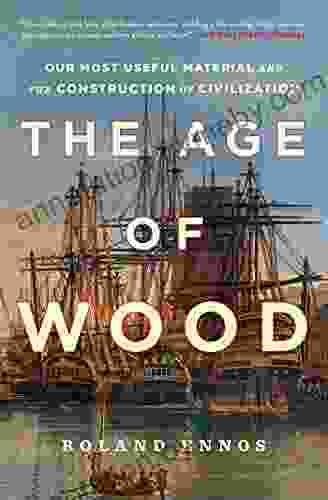Our Most Useful Material and the Construction of Civilization

4.4 out of 5
| Language | : | English |
| File size | : | 60159 KB |
| Text-to-Speech | : | Enabled |
| Screen Reader | : | Supported |
| Enhanced typesetting | : | Enabled |
| X-Ray | : | Enabled |
| Word Wise | : | Enabled |
| Print length | : | 333 pages |
A Journey through the History of Stone
Stone has been one of the most important materials in human history, used for everything from building homes to making tools to creating works of art. It is a versatile and durable material that has been used for centuries to construct some of the world's most iconic structures.
In this book, we will explore the history of stone, from its geological origins to its use in construction and architecture. We will also discuss the environmental impact of stone quarrying and mining, and the importance of preserving stone resources for future generations.
The Geological Origins of Stone
Stone is a natural material that is formed from the solidification of molten rock. When magma cools and solidifies, it forms igneous rocks such as granite, basalt, and andesite. These rocks are typically hard and durable, making them ideal for use in construction.
Over time, igneous rocks can be weathered and eroded by the forces of nature. This process creates sedimentary rocks such as sandstone, limestone, and shale. These rocks are typically softer and more porous than igneous rocks, making them easier to carve and shape.
Metamorphic rocks are formed when existing rocks are subjected to heat and pressure. This process can change the texture and composition of the original rocks, creating new rocks such as marble, slate, and quartzite. Metamorphic rocks are often harder and more durable than sedimentary rocks, making them ideal for use in construction and architecture.
The Use of Stone in Construction
Stone has been used in construction for centuries. The earliest known stone structures were built by the ancient Egyptians around 3000 BC. These structures were made from limestone and sandstone, and they included pyramids, temples, and tombs.
The Greeks and Romans also used stone extensively in construction. The Parthenon in Athens, Greece, is one of the most famous examples of Greek architecture. The Parthenon was built from marble, and it is considered to be one of the most beautiful buildings in the world.
The Romans were also known for their use of stone in construction. The Colosseum in Rome, Italy, is one of the largest amphitheaters ever built. The Colosseum was built from travertine, a type of limestone, and it could accommodate over 50,000 spectators.
Stone continued to be used in construction throughout the Middle Ages and the Renaissance. Many of the castles and cathedrals that were built during this period were made from stone. Stone was also used to build some of the world's most famous bridges, such as the London Bridge and the Brooklyn Bridge.
The Environmental Impact of Stone Quarrying and Mining
The quarrying and mining of stone can have a significant environmental impact. The process of extracting stone from the earth can damage the surrounding landscape, and it can also pollute the air and water. The dust and noise generated by stone quarrying and mining can also be a nuisance to nearby residents.
In addition, the quarrying and mining of stone can contribute to the depletion of natural resources. Stone is a non-renewable resource, and once it is quarried or mined, it cannot be replaced. It is important to use stone resources wisely and to minimize the environmental impact of stone quarrying and mining.
The Importance of Preserving Stone Resources
Stone is a valuable resource that has been used for centuries to construct some of the world's most iconic structures. It is important to preserve stone resources for future generations. This can be done by using stone resources wisely and by minimizing the environmental impact of stone quarrying and mining.
There are a number of things that can be done to preserve stone resources. One important step is to reduce the demand for stone. This can be done by using alternative materials in construction, such as concrete and steel. Another important step is to recycle stone. Stone that is no longer being used can be crushed and used as a fill material or as a base for roads.
Preserving stone resources is important for both environmental and cultural reasons. Stone is a valuable resource that has been used for centuries to construct some of the world's most iconic structures. It is important to use stone resources wisely and to minimize the environmental impact of stone quarrying and mining so that future generations can continue to enjoy the benefits of this amazing material.
4.4 out of 5
| Language | : | English |
| File size | : | 60159 KB |
| Text-to-Speech | : | Enabled |
| Screen Reader | : | Supported |
| Enhanced typesetting | : | Enabled |
| X-Ray | : | Enabled |
| Word Wise | : | Enabled |
| Print length | : | 333 pages |
Do you want to contribute by writing guest posts on this blog?
Please contact us and send us a resume of previous articles that you have written.
 Book
Book Novel
Novel Page
Page Chapter
Chapter Text
Text Story
Story Genre
Genre Reader
Reader Library
Library Paperback
Paperback E-book
E-book Magazine
Magazine Newspaper
Newspaper Paragraph
Paragraph Sentence
Sentence Bookmark
Bookmark Shelf
Shelf Glossary
Glossary Bibliography
Bibliography Foreword
Foreword Preface
Preface Synopsis
Synopsis Annotation
Annotation Footnote
Footnote Manuscript
Manuscript Scroll
Scroll Codex
Codex Tome
Tome Bestseller
Bestseller Classics
Classics Library card
Library card Narrative
Narrative Biography
Biography Autobiography
Autobiography Memoir
Memoir Reference
Reference Encyclopedia
Encyclopedia Joseph Plumb Martin
Joseph Plumb Martin Tim Z Hernandez
Tim Z Hernandez Heather Baker
Heather Baker Lamont U God Hawkins
Lamont U God Hawkins Terry Masear
Terry Masear Gregory L Morris
Gregory L Morris Steve Eddy
Steve Eddy Terri Paajanen
Terri Paajanen Dhonielle Clayton
Dhonielle Clayton Hector Jaimes
Hector Jaimes Don Cherry
Don Cherry Gene Perret
Gene Perret Sarah Dees
Sarah Dees Martin Wolf
Martin Wolf Dessi Parrish
Dessi Parrish P Planat
P Planat Dominique Dupuy
Dominique Dupuy Diana Estill
Diana Estill Nicolas Rothwell
Nicolas Rothwell Peter Chan
Peter Chan
Light bulbAdvertise smarter! Our strategic ad space ensures maximum exposure. Reserve your spot today!

 Edward BellUnveiling the Deep History of the Earliest States: A Journey Through Time and...
Edward BellUnveiling the Deep History of the Earliest States: A Journey Through Time and... Neil GaimanFollow ·6.7k
Neil GaimanFollow ·6.7k Glen PowellFollow ·9.3k
Glen PowellFollow ·9.3k Jeffrey HayesFollow ·12.5k
Jeffrey HayesFollow ·12.5k Vic ParkerFollow ·4.6k
Vic ParkerFollow ·4.6k Carter HayesFollow ·12.9k
Carter HayesFollow ·12.9k Ethan MitchellFollow ·12.7k
Ethan MitchellFollow ·12.7k Jaylen MitchellFollow ·13.7k
Jaylen MitchellFollow ·13.7k Ryūnosuke AkutagawaFollow ·13k
Ryūnosuke AkutagawaFollow ·13k

 Cruz Simmons
Cruz SimmonsGuide To Pencak Silat Kuntao And Traditional Weapons:...
Immerse yourself in the captivating world of...

 Dalton Foster
Dalton FosterUnlock Your Financial Freedom: Dive into the ABCs of Real...
Are you ready to embark on a...

 George Orwell
George OrwellThe Advanced Guide to Real Estate Investing: Your...
Are you ready to embark on...

 Will Ward
Will WardMargaret Laurence: The Making of a Writer
Margaret Laurence (1926-1987) was one of...

 Jorge Amado
Jorge AmadoThe ABCs of Property Management: A Comprehensive Guide...
Owning and managing rental...
4.4 out of 5
| Language | : | English |
| File size | : | 60159 KB |
| Text-to-Speech | : | Enabled |
| Screen Reader | : | Supported |
| Enhanced typesetting | : | Enabled |
| X-Ray | : | Enabled |
| Word Wise | : | Enabled |
| Print length | : | 333 pages |












